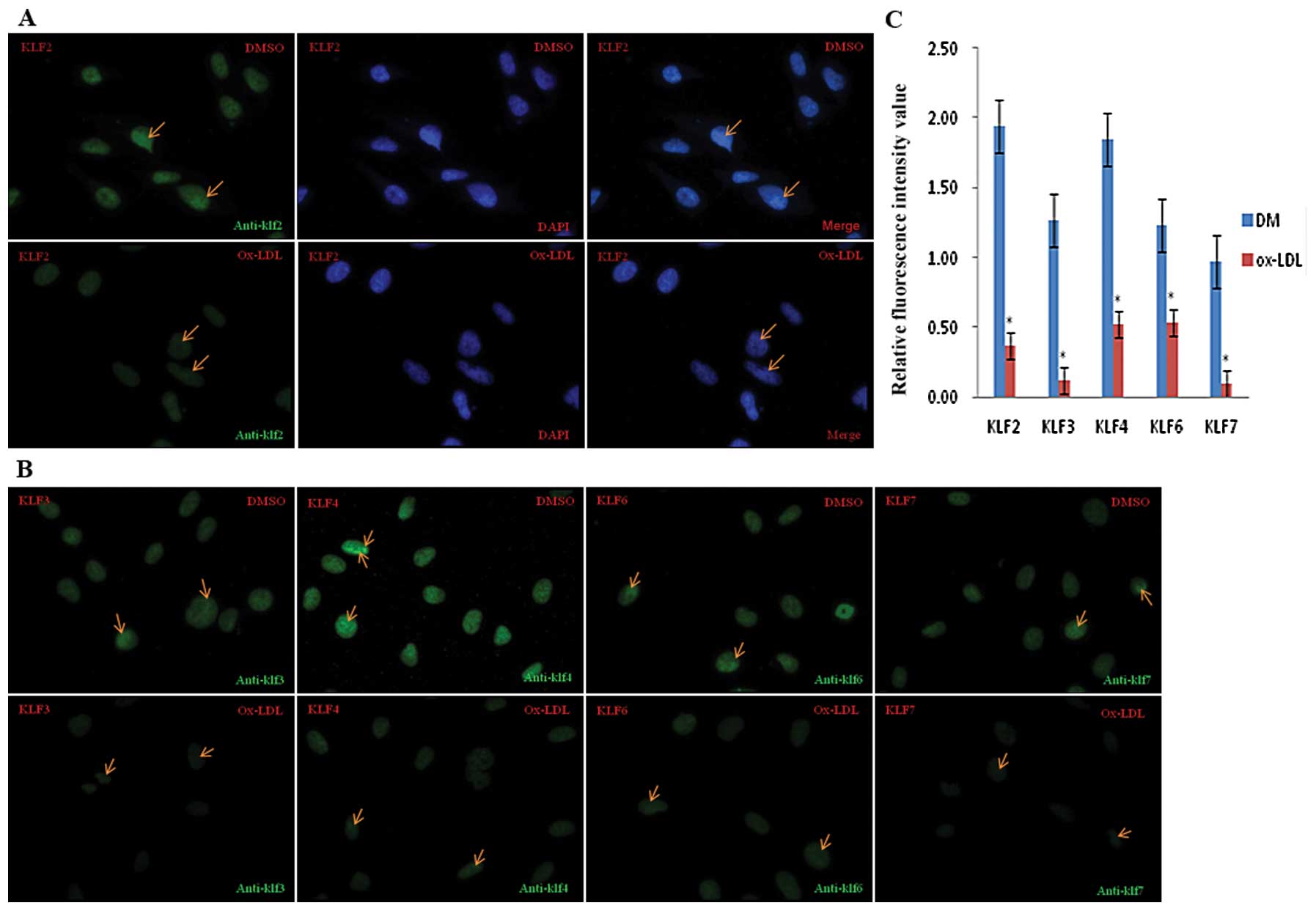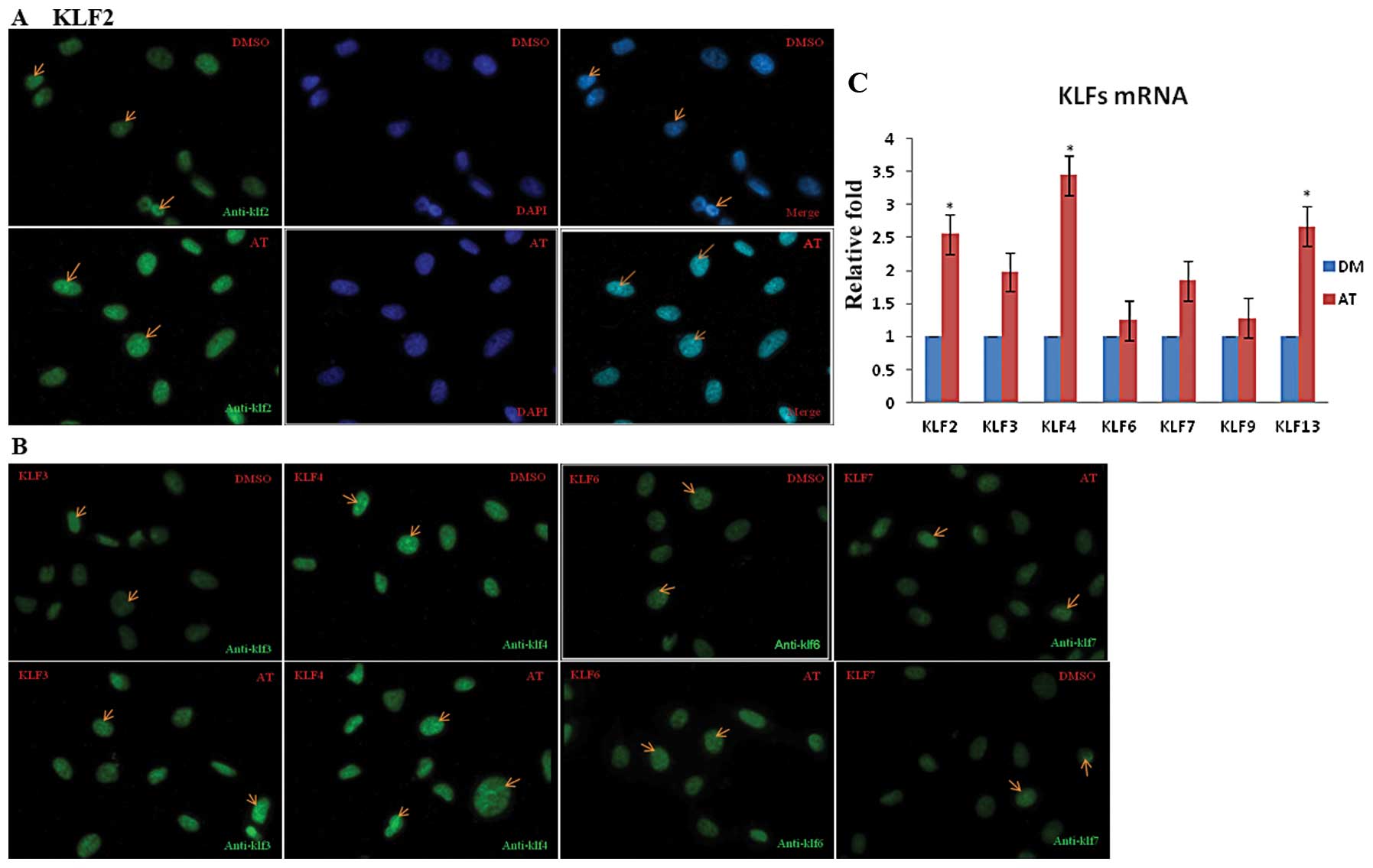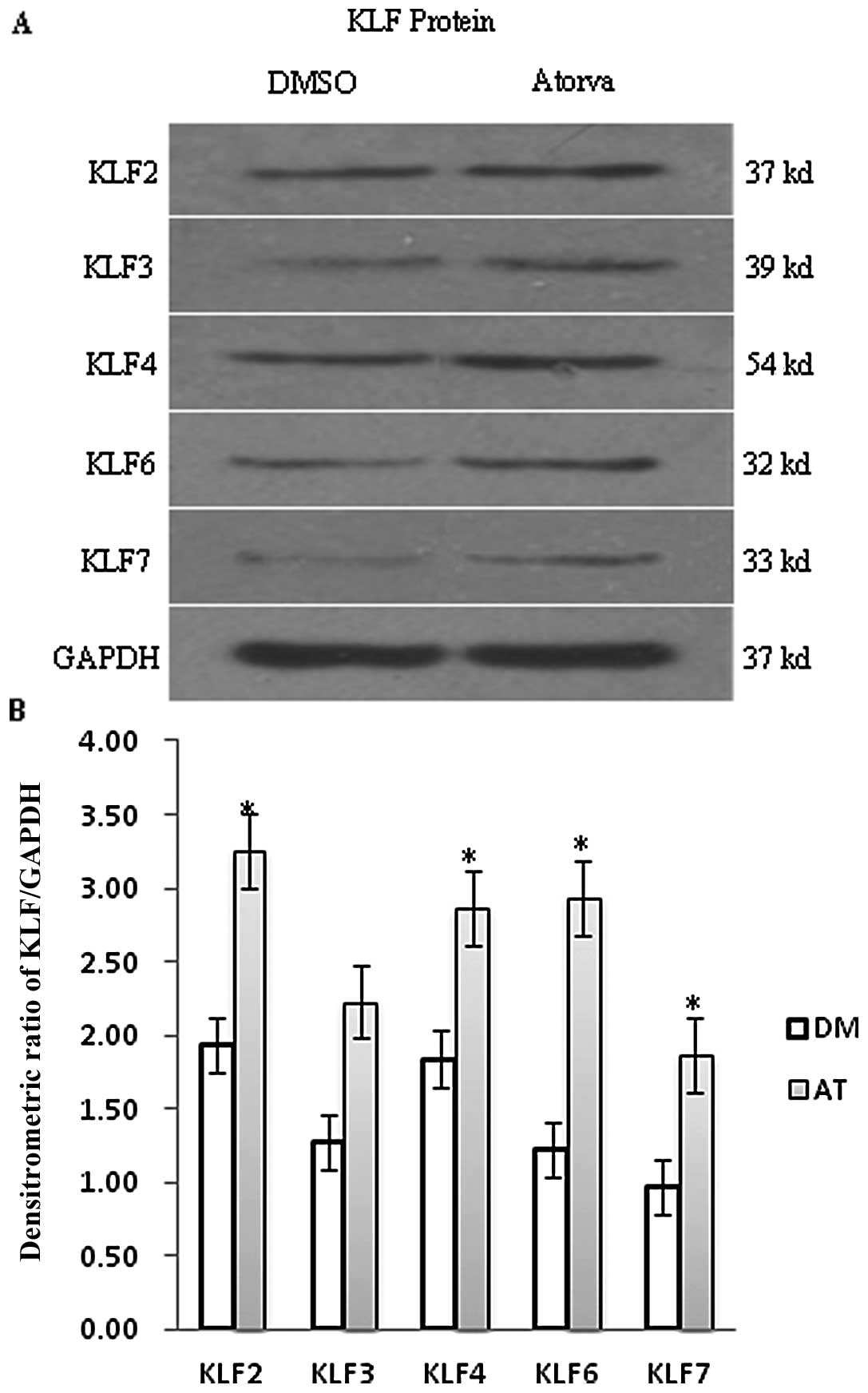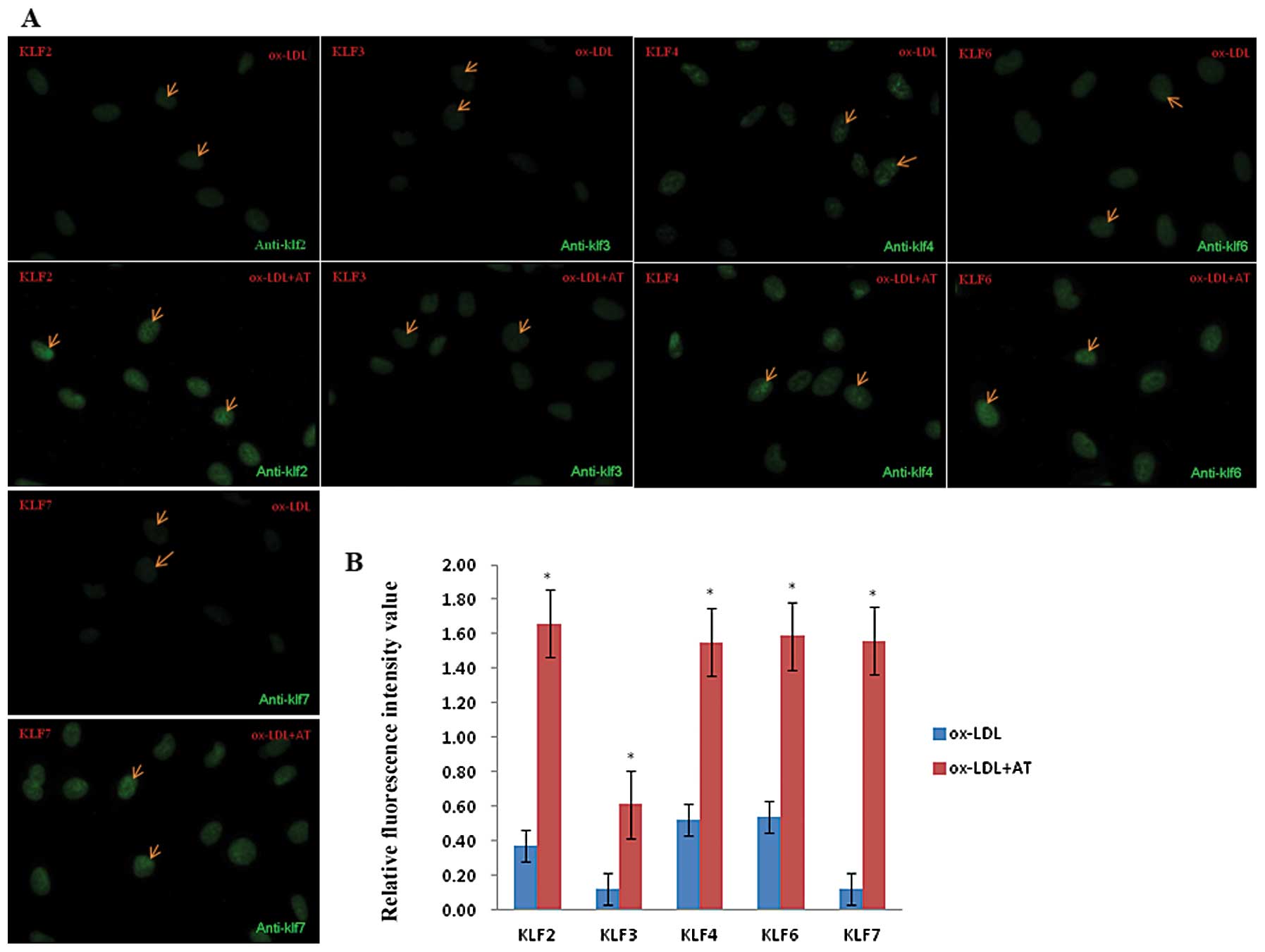Protective effects of atorvastatin against oxidized LDL-induced downregulation of KLF expression in EA.hy926 cells
- Authors:
- Published online on: May 14, 2012 https://doi.org/10.3892/ijmm.2012.999
- Pages: 330-336
Abstract
Introduction
Oxidized low-density lipoprotein (ox-LDL) has been demonstrated to be a key molecule in the initiation and development of atherosclerotic plaque (1), which is abundant in atherosclerotic arterial walls and has numerous detrimental effects on endothelial cell function (2). Recent clinical research has shown the association between circulating ox-LDL and preclinical atherosclerosis, coronary and peripheral artery atherosclerosis, and acute coronary syndromes (ACS) (3). The level of ox-LDL in circulation is a marker of the severity and course of ACS (4). Moreover, ox-LDL levels are independently associated with higher risk of progression in lacunar strokes (5). Recent studies have identified several mechanisms by which ox-LDL exerts its atherogenic effects, including activation of endothelial cell arginase II, which decreases endothelial nitric oxide (NO) production (6) and upregulation of inflammatory genes such as tumor necrosis factor (TNF)-α (7), adhesive factors, monocyte chemotactic agents (8) and metalloproteinases (9,10). Through these mechanisms, ox-LDL facilitates endothelial dysfunction, platelet aggregation and thrombus formation, leading to augmentation of the inflammatory reaction and destabilization of the atherosclerotic plaques (11). Interestingly, low concentrations of ox-LDL appear to have an opposite effect, as in vitro studies have shown that ox-LDL at low concentration can promote angiogenesis and activate nitric oxide synthesis in human coronary artery endothelial cells (12). These contradictory data show us that the mechanism of ox-LDL activity on endothelial cells is far beyond our current understanding.
Krüppel-like factors (KLF) are a subclass of evolutionarily conserved zinc finger-containing transcription factors. The expression of KLF2 and KLF4 has been documented in endothelial cells and the overexpression of these factors induces expression of multiple anti-inflammatory and anti-thrombotic factors, including endothelial nitric oxide synthase (NOS) and thrombomodulin. KLF2 and KLF4 are also novel regulators of endothelial activation in response to pro-inflammatory stimuli (13–15); however, no studies have been performed on the role of other KLF family members in endothelial function. Because ox-LDL is one of the initial triggers of atherosclerosis, these studies led us to the question whether ox-LDL exerts its atherogenic effects by signaling through the KLF family members. KLF2 and KLF4 showed opposing effects on some factors compared with ox-LDL, including eNOS and thrombomodulin, so we hypothesized that ox-LDL might reduce KLF production in endothelial cells.
Atorvastatin is a synthetic 3-hydroxy-3-methylglutaryl coenzyme A (HMG-CoA) reductase inhibitor and is used to treat patients with high cholesterol. In general, statins regulate endothelial function, inhibit macrophage activities, modulate several inflammatory mechanisms involved in the atherosclerotic process and inhibit migration and proliferation of endothelial smooth muscle cells. Studies have shown that atorvastatin decreases the amount of circulating ox-LDL (16) and increases the expression of atheroprotective genes such as KLF2 (17) and its downstream targets, namely, endothelial nitric oxide synthase (eNOS) and thrombomodulin (15), so we hypothesized that atorvastatin may also modulate other KLF family members.
This study aims to investigate the effect of ox-LDL on KLF expression and the role of atorvastatin in the regulation of KLF expression with or without ox-LDL induction. To conduct our experiments, we selected EA.hy926 cells as our model of macrovascular endothelial cells.
Materials and methods
Materials
The human umbilical vein endothelial cell line EA.hy926 was purchased from the cell bank of Institute of Cellular Biology (Chinese Academy of Science, Shanghai, China). Cell culture materials were from Costar (Corning Incorporation, Corning, NY, USA). Atorvastatin was purchased from the National Institute for the Control of Pharmaceutical and Biological Products (China). Other reagents are indicated in the text.
Cell culture and reagent preparation
The EA.hy926 endothelial cells were cultured in Dulbecco’s modified Eagle’s medium (DMEM) with 10% fetal bovine serum (FBS) (Gibco-BRL, Gaithersburg, MD, USA) and 1% penicillin/streptomycin at 37°C in a humidified atmosphere containing 95% O2 and 5% CO2. Experiments were performed with cells grown to a confluency of 80%. EA.hy926 cells at passages 3–5 were used in this study. Atorvastatin was dissolved in dimethyl sulfoxide (DMSO; Sigma, St. Louis, MO, USA) (stock 10 mM) and added to the cells at the indicated concentrations for the entire incubation period. The equivalent amount of DMSO was added to the control samples. The final concentration of DMSO never exceeded 0.1% and did not affect cell viability (data not shown).
DNA microarray
After EA.hy926 cells were treated with atorvastatin (10 μM) or control (DMSO) for 24 h, gene expression profiles were determined with Affymetrix U133A plus 2.0 genechip (CapitalBio Corporation, Beijing, China), which included 47,000 characterized human genes. Each group had 3 biological repeats.
Total-RNA was isolated using TRIzol® (Invitrogen, Inc., Grand Island, NY, USA) and purified using RNeasy spin columns (Qiagen, Hilden, Germany). Total-RNA (7 μg) was used to synthesize cDNA by using the Superscript II double-stranded cDNA synthesis kit (Applied Biosystems, Carlsbad, CA, USA) and the cDNA was then used for in vitro transcription in the presence of biotin-labeled ribonucleotides (biotin-11-CTPs und biotin-16-UTPs) to yield biotin-labeled cRNA. The biotin-labeled RNA fragments were hybridized to the probe array during 16 h of incubation, and then the array was stained with streptavidin-phycoerythrin conjugate and scanned by the GeneChip® Scanner 3000. Raw data were analyzed using Affymetrix® GeneChip® Operating Software Version 1.4.
Semi-quantitative real-time polymerase chain reaction (PCR)
RNA was extracted using TRIzol and quantified by measuring the absorbance at 260 nm. Reverse transcription was performed using the One Step RT-PCR kit (Promega Corporation, Madison, WI, USA), according to the manufacturer’s instructions. cDNA samples (2 μl) were amplified in 20 μl of 1X SYBR-Green PCR master mix (Applied Biosystems) and real-time PCR was performed on duplicate samples by using the Applied Biosystems ABI PRISM® 7300 Real-Time PCR System with the following cycling parameters: initial denaturation at 95°C for 10 min, followed by 40 cycles of denaturation at 95°C for 15 sec and annealing/extension at 61°C for 31 sec. Data were normalized to human GAPDH mRNA levels as an endogenous control and were expressed relative to the DMSO-treated control using the 2-ΔΔCt method. The primers were designed using Primer Express® Primer Design Software V3.0 (Applied Biosystems) (Table I).
Western blot analysis
Following treatment, cells were washed with ice-cold phosphate-buffered saline (PBS) and lysed with NucBuster™ protein extraction kit (Calbiochem Merck, Co., Darmstadt, Germany). Cell lysates were separated on SDS-PAGE and transferred to Whatman nitrocellulose membranes. The membranes were blocked with Blotto-Tween (5% nonfat milk and 0.05% Tween-20 in PBS) and incubated with primary antibodies against KLF2, KLF3, KLF4, KLF6 and KLF7 for 2 h at room temperature. After washing, the membranes were incubated with horseradish peroxidase-conjugated secondary antibodies. The bands were detected by chemiluminesence detection agents. The blots were subjected to densitometry and the bands were analyzed by Gene Genius bio imaging system (Syngene, Frederick, MD, USA).
Immunofluorescence and confocal microscopy
To explore the relationship between ox-LDL and the KLFs, we used immunofluorescence with specific primary antibodies against the members of the KLF family. EA.hy926 cells were plated onto glass coverslips, which were incubated in DMEM in the presence of DMSO control (A), 10 μM atorvastatin (B), 100 μg/ml ox-LDL (C) or 10 μM atorvastatin + 100 μg/ml ox-LDL (D) for 24 h. After incubation, the cells were fixed with 4% formaldehyde for 15 min, stained with anti-KLF antibody [goat KLF2, goat KLF3 and rabbit KLF6 antibodies (Santa Cruz Biotechnology, Inc., Santa Cruz, CA, USA), 1/500; mouse KLF4 antibody (ProMab Biotechnologies, Inc., Richmond, CA, USA), 1:800; rabbit KLF7 antibody (Proteintech Group, Inc., Chicago, IL, USA), 1:400] at 4°C overnight, and then incubated for 30 min with fluorescein-conjugated secondary antibodies (rabbit anti-goat IgG/HRP, 1:40,000; goat anti-mouse IgG/HRP,1:80,000 and goat anti-rabbit IgG/HRP, 1:40,000). Finally, immunostaining was performed, visualized and photographed using a Leica TCS-SP confocal laser-scanning microscope (11,12).
Statistical analysis
All experiments were performed in duplicate or triplicate with at least 2 biological replicates. All data are presented as mean ± standard deviation (SD). Comparisons among groups were performed by one-way ANOVA followed by a posteriori Tukey’s test. Differences were accepted as statistically significant when P<0.05.
Results
Ox-LDL downregulates KLF expression in EA.hy926 cells
To investigate the effect of ox-LDL on KLF expression, we used immunofluorescence and confocal microscopy to assess KLF protein levels in EA.hy926 cells treated with ox-LDL. As shown in Fig. 1A and B, KLF2, KLF3, KLF4, KLF6 and KLF7 (green) were all expressed in the nuclei, which are counter-stained with DAPI. KLF production was moderate without ox-LDL stimulation; however, incubation with 100 μg/ml ox-LDL for 24 h led to a significant decrease in KLF expression. The fluorescence intensity values of KLF2, KLF3, KLF4, KLF6 and KLF7 gene expression before and after ox-LDL treatment were quantitatively analyzed and the results indicate a >2-fold decrease in KLF expression after ox-LDL treatment (Fig. 1C).
Atorvastatin upregulates KLF expression in quiescent EA.hy926 cells
DNA microarray analysis reveals that atorvastatin elevates the expression of KLF family members
To discover the molecular mechanism for the pleiotropic effects of atorvastatin, we conducted a cell-based microarray analysis to analyze the genome-wide transcriptional changes occurring in EA.hy926 cells after exposure to 10 μM atorvastatin for 24 h. Atorvastatin increased the expression of all KLF genes by >2-fold compared to DMSO. KLF4 showed the maximum change, with >4-fold upregulation (Table II).
Real-time PCR analysis validates the effect of atorvastatin on KLF gene expression
To validate the effect of atorvastatin on KLF gene expression, we used real-time PCR to measure mRNA levels in the EA.hy926 cells treated with atorvastatin for 24 h. Under control (DMSO) conditions, KLF mRNA levels were low. Stimulation of EA.hy926 cells with 0.1–10 μM atorvastatin led to a concentration- and time-dependent increase in KLF mRNA expression that peaked 24 h after treatment with 10 μM atorvastatin (data not shown). After 24 h, the levels of KLF2, KLF4 and KLF13 mRNA were significantly higher in these cells than in the control cells (P<0.05) (as shown in Fig. 3C)
Atorvastatin promotes the expression of KLF protein in quiescent EA.hy926 cells
To confirm whether the change in KLF protein levels was consistent with PCR and DNA microarray results, KLF protein was analyzed and quantified by immunofluorescence and western blot analyses. As shown in Fig. 2, the expression of KLF2 and KLF4 protein in quiescent EA.hy924 cells was significantly higher than that of KLF3, KLF6 and KLF7. After incubation with 10 μM atorvastatin for 24 h, KLF2, KLF3, KFL4, KLF6 and KLF7 were all increased compared with the DMSO control, but protein levels were not altered to the same degree as the mRNA levels. The increase in KLF2 protein expression was <2-fold over that of the control and we found the same result by immunofluorescence analysis. Green fluorescence intensity values based on the binding intensity of the KLF antibodies were enhanced in the atorvastatin group compared to the DMSO group, but the change was <2-fold (Fig. 3A and B).
Atorvastatin counteracts ox-LDL-induced downregulation of KLF expression in EA.hy926 cells
As mentioned above, ox-LDL sharply decreased the levels of KLF protein, while atorvastatin upregulated the KLF expression at both the mRNA and protein levels. We further examined the effects of atorvastatin on ox-LDL-induced KLF expression by using immunofluorescence. In the nuclei of these cells, we observed a >2-fold decrease in KLF protein in the 100 μg/ml ox-LDL group compared to the DMSO control group (Fig. 1A and B), while the fluorescence intensity values of KLF2, KLF3, KLF4, KLF6 and KLF7 in ox-LDL + atorvastatin group were all elevated >3-fold over the ox-LDL alone group. These results demonstrate that atorvastatin counteracts the inhibitory effect induced by ox-LDL on KLF expression (Fig. 4).
Discussion
KLFs are members of the zinc finger family of transcription factors and previous studies have implicated these transcription factors as the key regulators of the endothelial pathways in vascular biology (18). KLF2 is the most widely studied KLF in endothelial cells and it is known as a ‘molecular switch’ that regulates the important aspects of vascular function and disease. KLF2 regulates endothelial thrombotic function by inducing the expression of potent anti-thrombotic and anti-inflammatory genes such as eNOS, thrombomodulin and plasminogen activator inhibitor 1 (PAI-1). These results were further substantiated by siRNA knockdown experiments (8). In addition, KLF2 blocks endothelial cell activation by inhibiting interleukin (IL)-1β (19) and TNF-α (20), and inhibits angiogenesis by reducing endothelial cell proliferation and migration (21).
Both KLF4 and KLF10 are novel regulators of the inflammatory response (22,23). KLF10 plays a central role in the anti-proliferative response via the TGFβ-Smad pathway, which explains why KLF10 knockout mice develop cardiac hypertrophy (24). KLF4, which acts as a novel regulator of macrophage polarization, was robustly induced in M2 macrophages, whereas it was strongly reduced in M1 macrophages (25). KLF6 plays a key role in vascular development, remodeling and response to injury (12). KLF7 was recently reported to be a novel candidate for conferring susceptibility to type 2 diabetes (26). However, the underlying mechanisms responsible for endothelial cell injury with decreased KLF expression, remain to be elucidated.
In atherosclerosis, ox-LDL accumulates in the vessel walls and causes endothelial dysfunction, leading to the initiation and progression of atherosclerosis. However, the association between ox-LDL accumulation and KLF expression, as well as the effect of atorvastatin on ox-LDL-induced KLF expression, has not been determined. Therefore, we examined the effect of atorvastatin on ox-LDL-induced regulation of endothelial cell KLF expression.
Several studies have demonstrated that KLF2 is a novel nuclear mediator of the effects of statin in endothelial cells (27–30). In the present study, we found that ox-LDL can significantly decrease the mRNA expression of KLF2, KLF3, KLF4, KLF6, KLF7, KLF9 and KLF13. We further demonstrated that the downregulation of KLF expression by ox-LDL was counteracted by treatment with atorvastatin. These findings suggest that other KLFs, in addition to KLF2 and KLF4, play a role in the pathogenesis of atherosclerosis (13,31). Downregulation of KLF expression by ox-LDL might be an effective target of atorvastatin in atherosclerosis. The signaling mechanisms orchestrating endothelial KLF2 expression as well as the expression of other KLFs in the vascular endothelium deserve further investigation.
Lectin-like oxidized low-density lipoprotein receptor-1 (LOX-1) is a major receptor for ox-LDL in the endothelial cells and is important for tumor growth, suggesting a molecular connection between atherogenesis and tumorigenesis (32–34). Recent studies show a positive correlation between increased serum ox-LDL levels and an increased risk of colon, breast, ovarian and esophageal cancers (35–37). Studies have revealed that KLF4, KLF9 and KLF10 have important tumor suppressor functions (23,26,38–40). Based on our results that ox-LDL downregulates KLF expression, which would increase the risk of cancer, we hypothesized that KLFs were the targets of the pro-carcinogenic effect of ox-LDL and the anti-carcinogenic effect of atorvastatin.
Maintenance of the cellular participants of inflammatory reactions in a quiescent or inflammatory state is equally important. Therefore, we investigated these two states. Atorvastatin upregulated KLF expression in both the quiescent and ox-LDL-induced inflammatory states. This suggests that KLFs are involved in the control of cell proliferation and differentiation in normal as well as in pathological situations.
Although the mechanism of KLF reduction by ox-LDL is not well understood in EA.hy926 endothelial cells, our observations suggest that KLFs regulate the endothelial phenotype under both basal and inflammatory conditions. The evidence suggests that KLFs play an important role in endothelial dysfunction. Moreover, statin-induced upregulation of KLF expression may play an important role in the pharmacological and clinical effects of statins observed in cardiovascular diseases and carcinoma. Downregulation of KLFs in patient plasma might occur during the early stages of cardiovascular disease and cancer, and this may be correlated with disease severity, because ox-LDL levels are related to both atherosclerosis and an increased risk of cancer (33). Further clinical research is required to provide more information on the potential benefits of using statins to treat atherosclerotic diseases at an earlier stage.
Acknowledgements
This study was supported by the National Science and Technology Support Program (no. 2009BAI86B04).













